Spring is the season when you can enjoy an abundance of seasonal ingredients. In the world of Japanese cuisine, spring brings with it a colorful array of fresh vegetables, wild plants, and seafood. Japanese tableware is essential to making use of these seasonal ingredients. Japanese tableware brings out the blessings of the season with its beautiful design and functionality. Also, by combining various Japanese tableware, you can make your dining table even more gorgeous. This time, new works by Karatsu ware artist Naoki Kojima have arrived, so we would like to introduce them and tell you about the charm of Japanese tableware.

Kappo restaurants and Japanese restaurants that serve traditional cuisine with seasonal ingredients use a variety of Japanese tableware, among which is "mukozuke" tableware. Originally, kaiseki cuisine had a menu called ``mukozuke,'' which referred to the dishes and utensils. The rice bowl is on the left, the soup bowl is on the right, and the dish is placed on the other side, which is why it is called ``mukozuke.'' The mukozuke (vessel) in kaiseki cuisine is placed on the table from beginning to end, so it is also used as a serving bowl after the first dish is eaten. Mukozuke is the face of kaiseki cuisine, so it is often made with seasonal items or unique shapes.
We would like to introduce some of the ``mukotsuke'' by Karatsu ware artist Naoki Kojima.
“Mukozuke” is attractive due to its asymmetrical “distortion” beauty.
This work, which is incomplete, unbalanced, and full of change, does not have the coldness of a machine-made work, but instead feels the warmth of a human-made work. The soft, unbalanced shape gives us a sense of natural beauty and familiarity.
“E-Karatsu mukozuke” *Click here for the product page
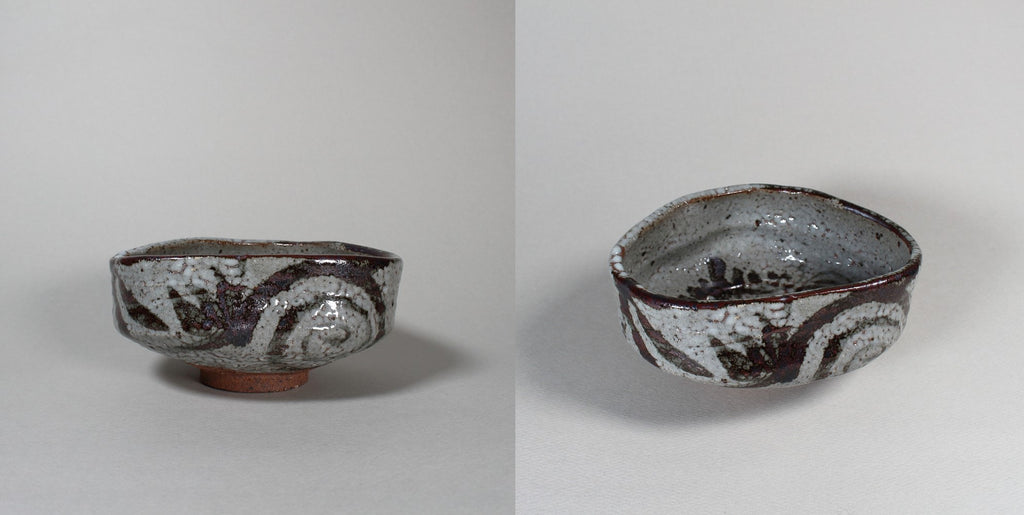
This is a E-Karatsu mukozuke, which is a representative technique of Karatsu ware. Naoki Kojima's free-spirited iron painting and powerful brush strokes are attractive. A pine tree is drawn in the prospect. Pine is a tree that is familiar to Japanese people, and is considered an auspicious tree, as it is represented in the 'shochikubai' (pine, bamboo and plum trees). There are also pine trees that are said to be several thousand years old, and are considered to be auspicious as they are associated with eternal youth and longevity. It is often used at celebratory events.
“Kohiki Mukozuke” *Click here for the product page
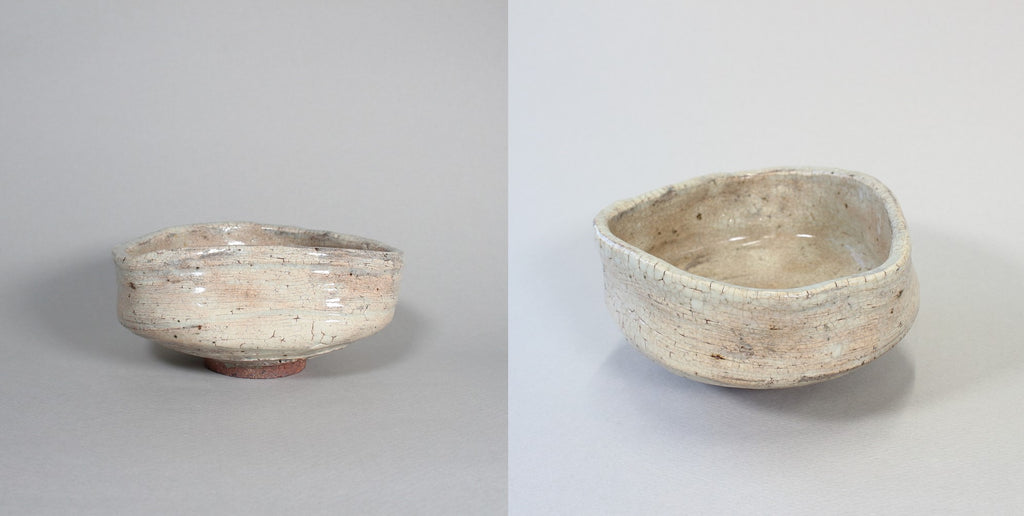
It is made by covering the base with a layer of white clay, then applying a transparent glaze over it and firing it. It is said that it got its name because it has a texture that resembles white powder blowing. It has a beautiful warm white color that is different from Madara Karatsu, and you can enjoy the change in color as you use it.
“Karatsu Jakatsu Mukozuke” *Click here for the product page
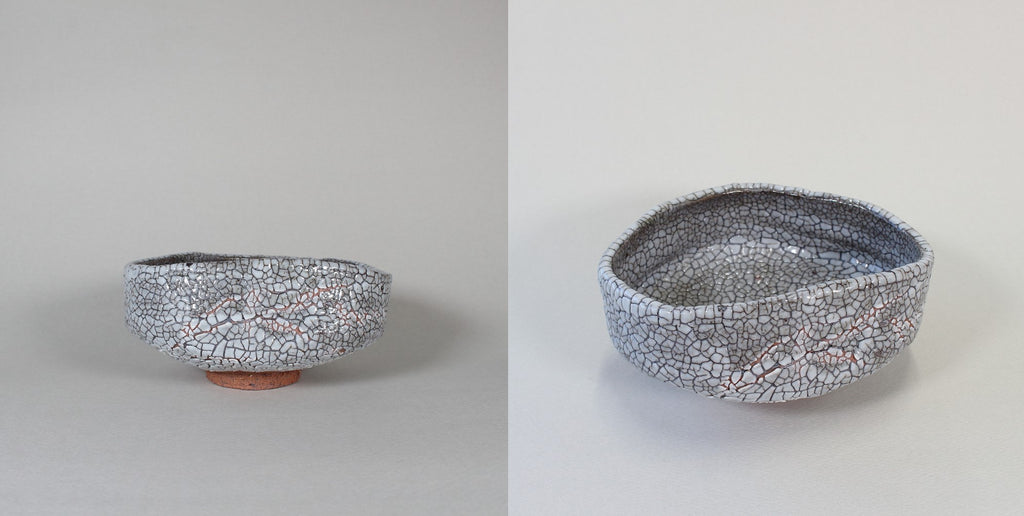
In Karatsu ware, there is a type of glaze that is intentionally penetrated, called jakatsuyu. A black glaze containing iron is coated with a cloudy glaze such as straw ash or feldspar. When the feldspar is fired, it curls on the surface, revealing the underlying black glaze. It came to be called Jakatsu because its curly surface resembled the epidermis of a snake or scorpion. It is a mukozuke that is unique to connoisseurs.
“E-Karatsu Clam Mukozuke” *Click here for the product page (left : gray / right : reddish brown)
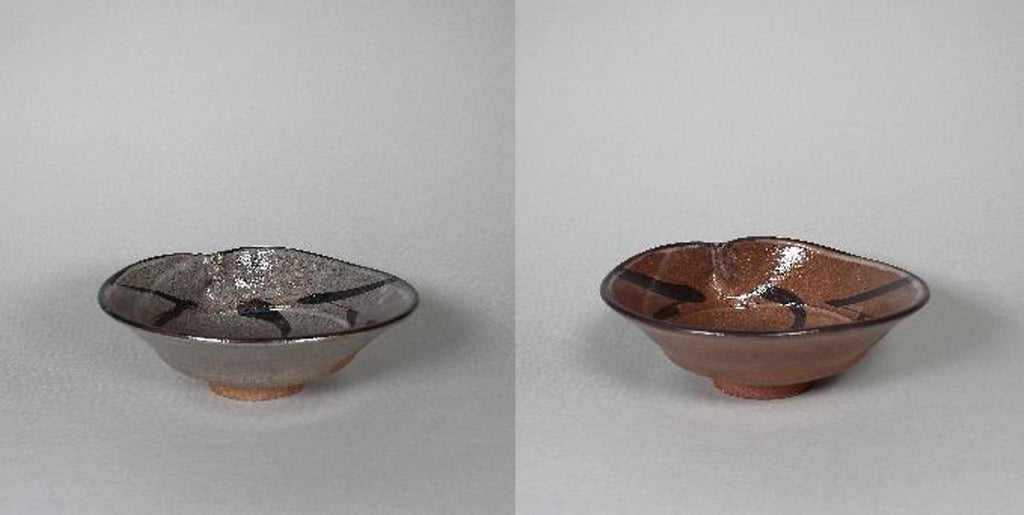
This mukozuke is in the shape of a clam, which is the traditional shape of Karatsu ware. A grass pattern is drawn on the inside. In fact, shapes imitating clams can be seen not only in Karatsu ware but also in many traditional crafts such as lacquerware. Because bivalves such as clams never match with anything other than paired shells, it is said to be a symbol of ``husband and wife husband and wife'' and ``prosperity of descendants,'' and is considered to be an auspicious design.
“Kohiki Mukozuke” *Click here for the product page
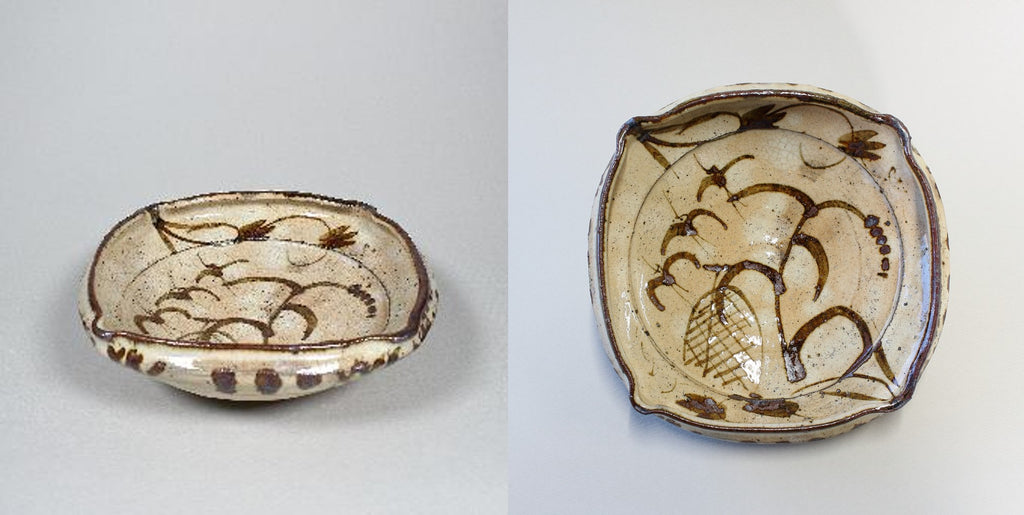
This is a mukozuke with picture Karatsu applied to Kohiki Karatsu. The freely drawn grass and bird patterns are attractive. As it is large and deep, it can also be used as a pot.
The mukozuke I introduced is a type of mukozuke that is often used in Japanese and Japanese restaurants. The dining table will become even more prestigious. You can serve it with aemono or simmered dishes, and it's also perfect for sashimi. Karatsu ware also has excellent functionality and has the ability to maintain temperature (hard to heat up and cool down). If you chill the plate in the refrigerator, the sashimi will stay cold and can be eaten at the optimal temperature. Mukozuke is a container for serving small dishes, and is the perfect size for serving one person's food. Mukozuke enhances the beauty of the dish and brings out the flavor of the ingredients.
We would also like to introduce some "small plates" made by Karatsu ware.
"Karatsu plate" *Click here for the product page (left : E-Karatsu / center : green / right : Hakeme)
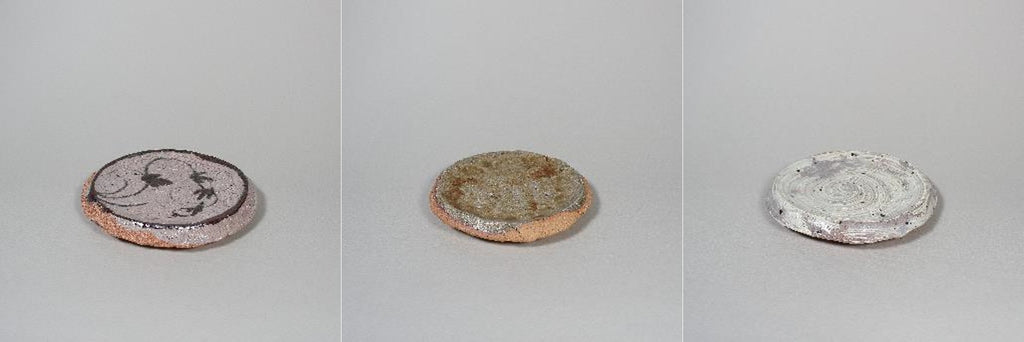
It is a plate about 4 to 5 inches in size. The bold design typical of Naoki Kojima and the earthy flavor unique to Karatsu are attractive. It is thick and heavy, and although small, it has a presence. We offer three series: ``E-Karatsu'', which is made using traditional Karatsu ware techniques, ``Green'', which has a green glaze made from natural ash, and ``Hakeme'', which is made by applying white mud with a brush to create a dynamic feel. It can be used as a plate for side dishes, pickles, etc., or as a plate for placing Japanese sweets, etc. Since it is not deep and has a flat shape, it is also ideal for skewers such as skewers and yakitori.
“MadaraKaratsu Yamase Mukozuki” *Click here for the product page (left : yellow/right : gray)
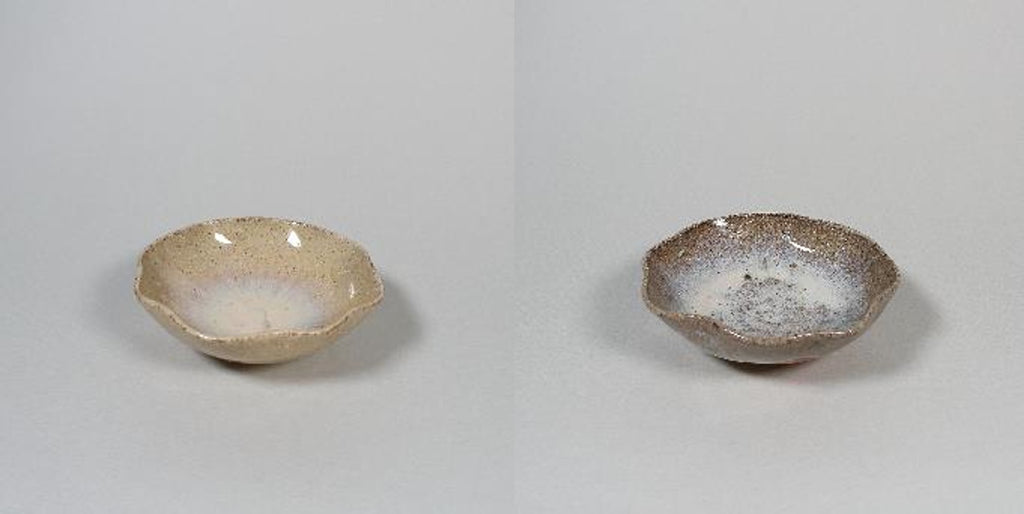
Using precious Yamase clay, each piece is carefully turned on a potter's wheel and glazed with glutinous rice straw ash. Even if the same clay from Yamase is used, the color of the kiln will vary depending on the time of firing, location, number of firewood, weather and humidity. This time, we have a work with a strong yellow color and a work with a strong gray color. If you look closely, you can see that both of them have fine penetrations, and the blue color is so beautiful that you will be enchanted by it. You can also enjoy the baked color of the exposed clay foot ring. the rough shavings, the glaze buildup, etc. In terms of size, it is suitable for small plates and serving plates.
Each piece of pottery has a different penetration and flow of glaze, giving it a unique look that is different from those produced in mass quantities by machines. How about a warm bowl for your daily dining table?
Finally, let me introduce some Karatsu ware teacups.
April is also the time when new tea (Ichibancha) is on the market. Tea trees store nutrients during the winter, and in the warm spring, they grow as new shoots, and the first tea leaves that are harvested are rich in nutrients. Why not enjoy fresh tea full of ``seasonal flavor'' in your favorite teacup? There are two main types of teacups.
We recommend using a thick cylindrical teacup to prevent bancha and hojicha tea, which are brewed with boiling water, from being too hot to the touch. For high-quality sencha and gyokuro tea, we recommend a thin, wide-opening teacup because you can brew it at a temperature that isn't too hot. Kumidashi tea bowls are also commonly used for guests. A Karatsu ware teacup with a soft texture that can only be achieved by its earthy flavor and fits comfortably in your hand, I think it would also be a great gift for a loved one.
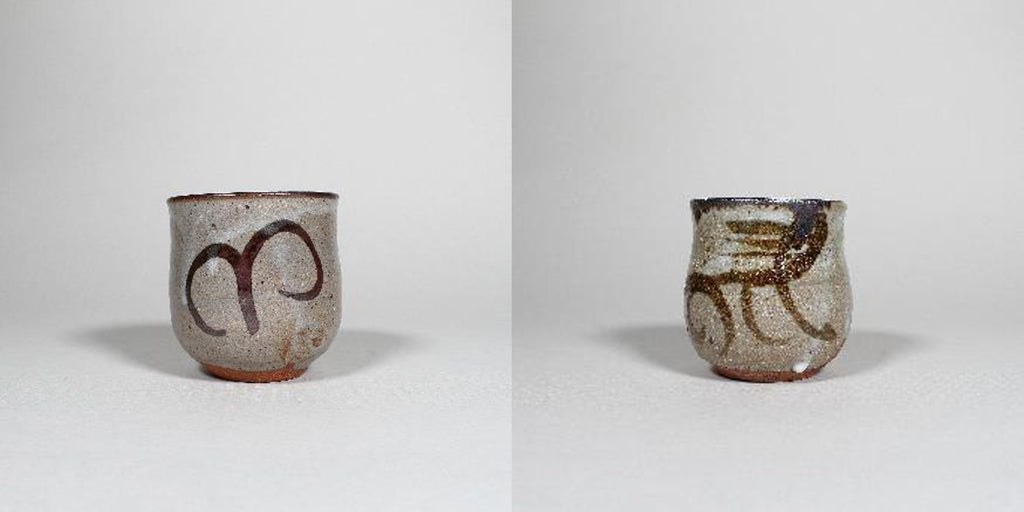


The Japanese tableware introduced this time will enhance the taste and beauty of your dishes. With the arrival of spring, why not fully enjoy the charm of Japanese tableware and welcome the new season with a rich spirit?
・Kojima's Karatsu ware, tea ceremony utensils and sake cups are also attractive. Click here to see his works, including those introduced here.
https://andpolite.com/en-usa/collections/naoki-kojima
・If you are interested in an interview with Mr. Kojima and the history of Karatsu-yaki, please click here.
https://andpolite.com/en-usa/blogs/artist-craftsman/naoki-kojima
<Trivia>
What is the difference between a “Kappo restaurant” and a “Japanese restaurant”?
Kappo restaurant
A kappo restaurant is a restaurant that specializes in high-quality Japanese cuisine, primarily serving traditional kaiseki cuisine. Each dish is carefully prepared and features dishes that make use of seasonal ingredients. The head chef and other craftsmen may cook the food right in front of the customers, either at the counter or in a private room. Generally speaking, Kappo course meals are the norm, and there is particularity to the order and combination of dishes along the course. Each dish is luxurious and features the chef's skill and seasonal ingredients.
Japanese restaurant
A Japanese restaurant is a restaurant that serves a wide range of Japanese cuisine, including sushi, sashimi, tempura, and hot pot dishes in addition to kaiseki cuisine. They tend to have a wide variety of dishes and a relatively casual atmosphere, and may also offer a la carte menus or set meals. Food presentation methods and dining styles vary by store and region.
A series of stories about “Japanese ware” that makes you want to tell someone.
・Kyushu, the Kingdom of Pottery|05_A story about “Japanese ware” that makes you want to tell someone.

